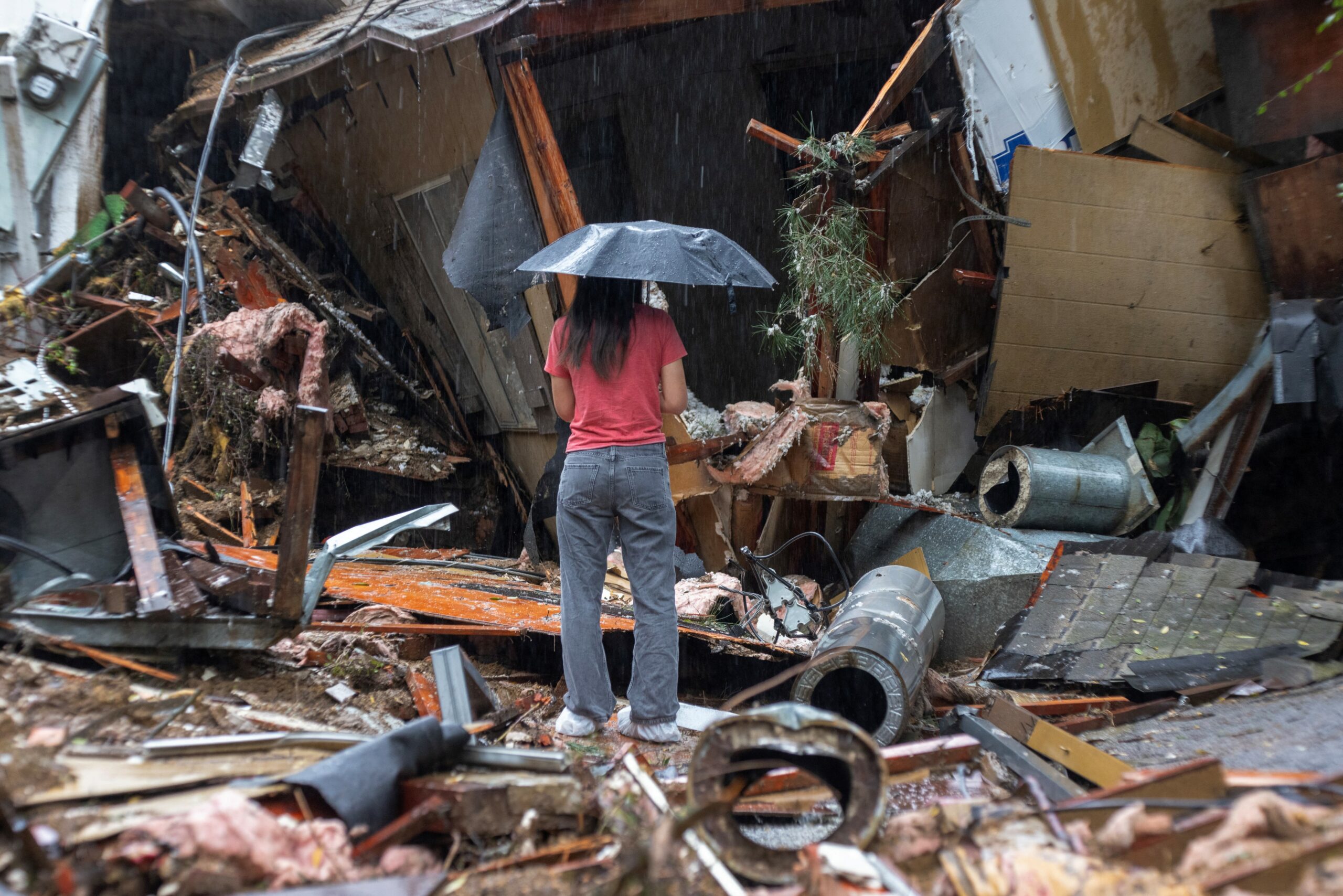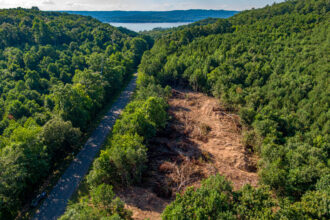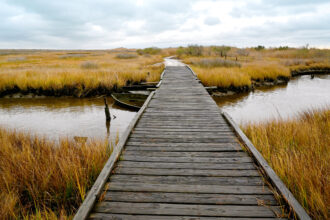This summer has brought a revolving door of climate-fueled disasters across the U.S.—from Hurricane Beryl in Houston to the wildfires tearing through California.
But what happens in the aftermath of these extreme weather events? For many states, recovery is no longer just about trying to return to normal, but rather rebuilding to prepare for future disasters as climate change accelerates.
A recent string of federal policies and a growing push from the insurance industry has made climate-minded disaster recovery more urgent than ever before, experts say.
Floodplains, Refined: Historically, the Federal Emergency Management Agency (FEMA) has categorized a floodplain as an area with a 1 percent chance of significant annual flooding. This standard has helped determine how and where structures should be rebuilt after a flooding disaster.
However, this definition has largely failed to take the latest climate science into account—until now. The Biden administration issued an executive order on July 10 enabling FEMA to factor growing flood risks from climate change into floodplain assessments. Under that order, FEMA will require that construction projects using the agency’s funding are built at a higher elevation or moved out of high-risk areas altogether.
This policy will “enhance resilience in flood-prone communities by taking future flood risk into consideration when we rebuild,” FEMA Administrator Deanne Criswell said during a press briefing.
The rule could cost FEMA an estimated additional $150 million over the next decade to elevate or fortify construction against flooding. However, as Grist’s Jake Bittle points out, this is a “proportionally small sum given the agency’s $3 billion annual disaster spending” and could save the agency money within the next 60 years if it has to respond to less flood-related destruction.
While FEMA covers around 75 percent of emergency recovery during qualifying flood events, that still leaves a quarter of the bill for communities, and some home builders have opposed the ruling in the face of higher costs. The recent overturning of the Chevron doctrine could also reduce FEMA’s ability to carry out this type of mandate, but Criswell told The New York Times that she is confident the agency still has legal authority in this scenario.
In January, FEMA also announced increased funds to reimburse local governments for installing energy-efficient technology like solar panels and heat pumps following disasters to help speed up the clean-energy transition.
“After a disaster, communities don’t just want to build back. They want infrastructure that will last and will serve them better in a future that promises more extreme weather events fueled by the climate crisis,” John Podesta, senior advisor to the president for clean energy innovation and implementation, said in a statement following the announcement.
These decisions come as insurers are raising premiums or pulling out of states such as Florida, battered by supercharged storms and accelerating sea-level rise—a trend my colleague Amy Green wrote about in March.
Fireproofing Homes: Insurers are also getting shaky in the face of wildfires, with major companies like State Farm, Allstate and Farmers limiting coverage in parts of California and Colorado. Here’s the economic logic behind some of those decisions: From 2017 to 2018, insurers paid out $29 billion in claims related to California wildfires, while only pulling in $15.6 billion in premiums.
Insurance companies are grappling with how to price climate-related wildfire risks. An insurance reform proposal working its way through California’s legislature would expand their options, allowing them for the first time to factor forward-looking climate models into their costs. The catch is that they must offer policies to 85 percent of homeowners in wildfire-distressed areas.
“This is another critical action to help fix California’s decades-old insurance crisis. It will help homeowners who face higher threats of wildfire get the coverage they need,” California Gov. Gavin Newsom said in support of the plan. “As the climate crisis has rapidly intensified, the insurance system hasn’t been seriously reformed in 30 years.”
Meanwhile, the Insurance Institute for Business and Home Safety—a nonprofit backed by more than 100 insurance companies—is taking a different approach. The organization is pushing for new standards that would require homeowners to build more fire-resistant homes, both before and after wildfire events, The New York Times reports.
People can take a number of steps to fortify their home and the area around it against an inferno. Experts say to focus on using non-flammable building materials on weak points of the house, including the roof, windows, siding and vents.
Outside the house, “the most common risks are having flammable mulch, plants, firewood, lawn furniture, decks and fences,” Bryce Young and Chris Moran, researchers at the University of Montana, write in The Conversation. They both work for wildfire threat assessment research firm Pyrologix. “These items have been a primary reason homes burned in many wildfires.”
That includes the 2018 Camp Fire, which virtually decimated the town of Paradise, California. Since then, residents of the town have spent years rebuilding structures to meet rigorous fire-resistance standards in hopes of avoiding a similar fate—a strategy that disaster-impacted communities are following across the country.
More Top Climate News
Many business owners and tourists on Nantucket, Massachusetts, are up in arms this week as debris from a broken offshore wind turbine blade washes up on the island’s popular beaches, New Hampshire Public Radio reports. Vineyard Wind, the company that owns the turbine, has workers combing the beaches to gather debris from the blade, which the company says is still mostly intact.
Meanwhile, a number of farmworkers in Colorado tested positive for bird flu earlier this week, Reuters reports. The staff were working under extremely hot conditions, making it difficult to wear protective gear, which may have increased the workers’ exposure to the virus, the U.S. Centers for Disease Control and Prevention said. In April, I wrote about the link between climate change and bird flu—which has been picking its way through the animal kingdom—and this situation adds a new climate-related factor to that list. It also calls attention to the harsh conditions many farmworkers are subjected to, though a new nationwide heat protection standard could help change that, writes my colleague Liza Gross.
In other news, Puerto Rico filed a billion-dollar lawsuit against fossil fuel giants, including ExxonMobil, BP and Chevron, The Verge reports. The island claims these companies violated trade laws by pushing fossil fuels without communicating their climate risks to the public. In recent years, the people of Puerto Rico have endured a series of extreme weather events such as Hurricane Maria, which research says was fueled by climate change.
About This Story
Perhaps you noticed: This story, like all the news we publish, is free to read. That’s because Inside Climate News is a 501c3 nonprofit organization. We do not charge a subscription fee, lock our news behind a paywall, or clutter our website with ads. We make our news on climate and the environment freely available to you and anyone who wants it.
That’s not all. We also share our news for free with scores of other media organizations around the country. Many of them can’t afford to do environmental journalism of their own. We’ve built bureaus from coast to coast to report local stories, collaborate with local newsrooms and co-publish articles so that this vital work is shared as widely as possible.
Two of us launched ICN in 2007. Six years later we earned a Pulitzer Prize for National Reporting, and now we run the oldest and largest dedicated climate newsroom in the nation. We tell the story in all its complexity. We hold polluters accountable. We expose environmental injustice. We debunk misinformation. We scrutinize solutions and inspire action.
Donations from readers like you fund every aspect of what we do. If you don’t already, will you support our ongoing work, our reporting on the biggest crisis facing our planet, and help us reach even more readers in more places?
Please take a moment to make a tax-deductible donation. Every one of them makes a difference.
Thank you,












